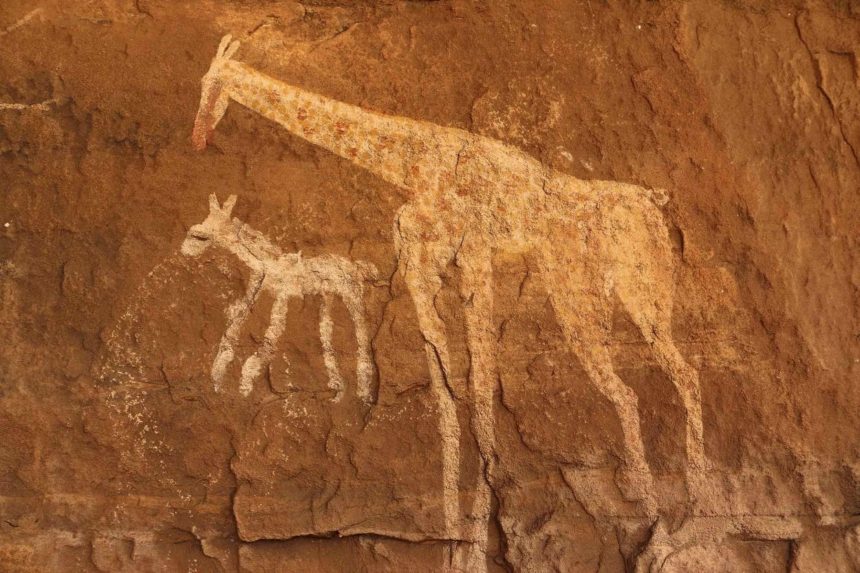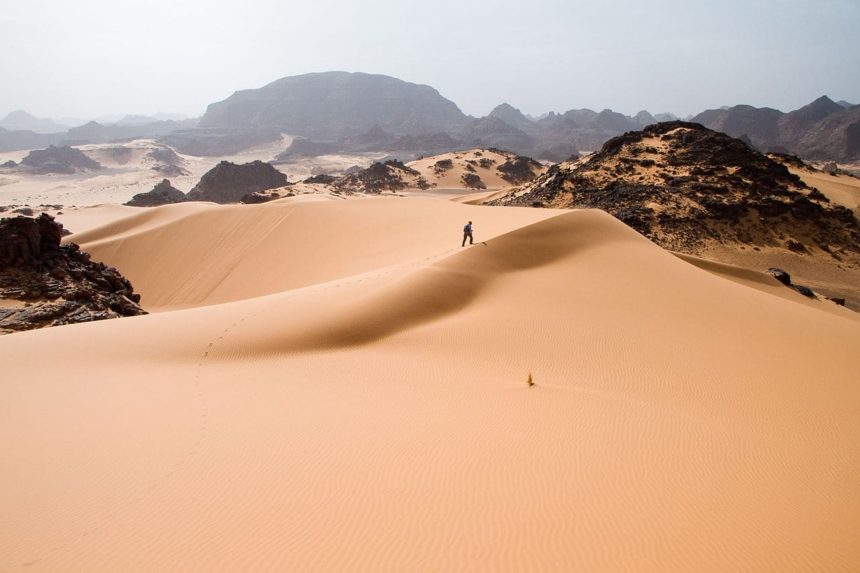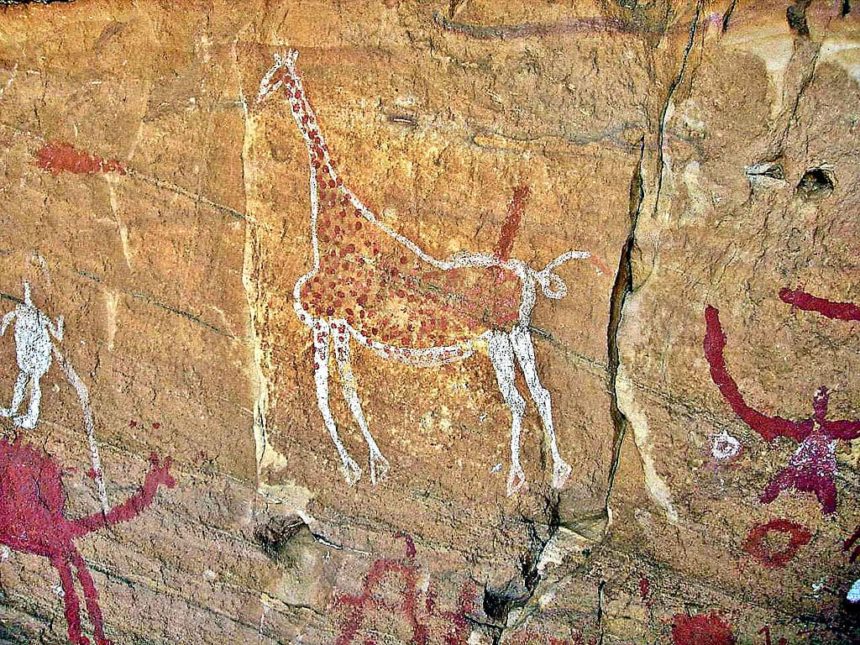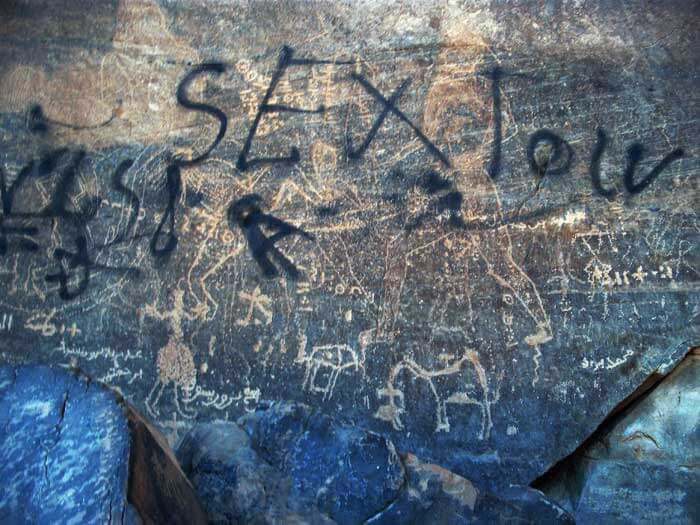The Tadrart Acacus is a massif averaging 150km long and 50km wide located in the Fazzan region, in the south western corner of Libya. this rocky massif has thousands of cave paintings in very different styles, dating from 12,000 B.C. to A.D. 100. In addition, there is numerous of rock art sites in Tadrart Acacus including hundreds of engravings and thousands of paintings.
It was included in 1985 on the UNESCO list of World Heritage Sites. More than a century after the first reports of prehistoric carvings.
There are paintings and carvings of animals such as giraffes, elephants, ostriches and camels, but also of men and horses. Men are depicted in various daily life situations, for example while making music and dancing.

This incredible open-air gallery tells the story of the changing fortunes of this part of the Sahara and the people who have occupied the area over the millennia. It is a story that traces the environmental effects of climate change which can be divided into distinct periods according to the characteristics of the rock-art legacy.
The oldest art belongs to the so-called Wild Fauna Period (10,000-6,000 BC) characterised by the portrayal of animals – elephants, giraffes, hippos and rhinos – that inhabited the area when it was much wetter than today.

Overlapping with this era is the Round Head Period (8,000-6,000 BC) when human figures appear alongside painted circular heads devoid of features. At this time people were living as hunter-gatherers, but this gradually gave way to the Pastoral Period (5500-2000 BC) characterised by art that depicts the introduction of domesticated cattle, and a more settled existence with human figures handling spears and performing ceremonies.
As the climate became progressively drier and long-distance travel more important, the art of the Horse Period (1000 BC – AD 1) shows the introduction of horses and horse-drawn chariots.
Finally, the most recent period of rock-art in the Sahara (from about 200 BC to present) is the Camel Period, as these animals have played an increasingly important role.

Vandalism and destruction of Rock-art of Tadrart Acacus
The rock art sites of Tadrart Acacus have survived for 14,000 years in the desert of southern Libya, but they are now under serious threat. Since 2009, vandalism has been a continuous problem: graffiti has been spray-painted across the surface of many of the paintings, and people have carved their initials into the rocks. But despite UNESCO’s and other organizations’ calls for the government to intervene with restoration and security measures, efforts to protect this precious ancient site have been gravely hampered by armed conflict and political chaos.
Libya experienced a political revolution in 2011 with the ousting of Muammar Gaddafi, and since then the country has been in a state of civil war.

Savino di Lernia, an archaeologist at Sapienza University of Rome who has worked extensively in the Tadrart Acacus mountains, explains how dangerous the area—formerly a tourist destination—has become:
Today, the site is inaccessible: no commercial flight connects Tripoli and Ghat, a nearby town (a weekly military aircraft brings food, essential goods and first-aid equipment). The tarred road between Ghat and Ubari is broken up, and clashes between the Tebu and Tuareg tribes increasingly affect the area….Being a Saharan archaeologist today is a difficult job. Researchers fear being kidnapped or even killed.
Savino di Lernia
Yahya Saleh, a local tour guide, mourns the fact that local hunters now regularly scrawl their names across the art: “People do not know the value of this. There are supposed to be people to protect these areas…because if this issue persists, then they will be gone within two years.”

The ongoing vandalism of the Tadrart Acacus sites is only one of the many overwhelming difficulties Libya faces with regard to cultural heritage protection. As di Lernia notes,
Perhaps the greatest threat to Libya’s diverse heritage is the trafficking of archaeological materials, for profit or to fund radical groups….No one has been able to fully assess the situation in Libya. Going to work among the black smoke of grenades, the men and women of the Libyan Department of Antiquities are doing their best. But museums are closed and the little activity left in the field is limited to the north.
Savino di Lernia
Until the fighting in Libya stops and archaeologists can again effectively cooperate with the government and international organizations to restore and protect sites like the rock art at Tadrart Acacus, Libya’s rich trove of monuments and artifacts will continue to be endangered.
Source:
– The History of Rock Art Research in the Tadrart Acacus (Southwest Libya). Electronic Document
– Cultural heritage: Save Libyan archaeology, Natute.com


